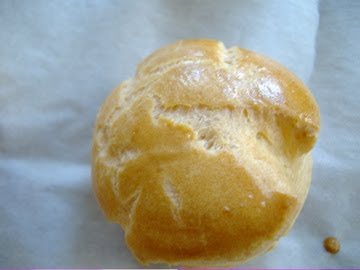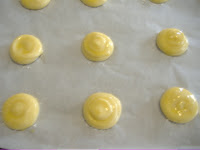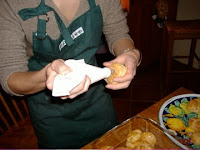A Zombie in Apple Season
I've missed apple season. It's sad, because I love autumn's flavors and possibilities, bits of sunny warmth studded through cold days the way fresh apple bits might stud a quick loaf with little bursts of sweetness on the tongue.
In a typical year, I would celebrate apple season, making the trek to an orchard or two to pick up apples and then cooking apple dishes for an entire weekend. This is what I like to call AppleFest. But AppleFest didn't happen this year.
Instead, I was busy running red lights (something I don't recall ever doing in my life) as I made my sleepy trip to school in the early morning darkness, arriving to an unlit hallway where my heels echoed across the old-school black and white tiles. Lights. I kept thinking. Lights would be nice. But the special key to turn on the lights doesn't arrive until around 7 am, and so I walk blindly through the dark hallway until I reach my office.
There is undoubtedly something wrong about waking at 4 am and coming home at almost 8 and working some more until you fall asleep, five days per week, then working two full days on Saturday and Sunday. When the 12 or 14 hour work days are not just a phenomenon of the beginning of another school year but the norm for a 12-month year, it can seem crazy. Yet it's a hard problem to see in the darkness of early morning when you've got copies to make, think-alouds to go over in your mind, rooms to set up, students waiting, when the line at the copier at 6:15 includes not just you but five others.
One morning, waking at 3:30 in the now chilly darkness of September and driving in a zombie-esque trance to school, I realized something was not okay. It's hard to see the problem when there are others involved, when normal is 12 hour work days that extend even longer into your bedtime once you get home, when you do it under the noble name of teaching. But that morning, arriving at 5:00 am to a parking lot not empty, I began to wonder what was wrong with all of us. All I could think about were the sweet apples ripening on trees somewhere, apples that might have ripened for me but that I will never taste.
Symbolic Apples and Other Teaching Matters
Apples are supposed to be the symbol of knowledge, of teaching. But, when the only apples I've seen this season are the ones in my mind or the bruised and mealy grocery store apples I throw in my lunch box to be eaten while I'm lesson planning, the ones that lack real juice, I can't help but wonder just what kind of knowledge we're passing on. When apples are a part of their own school lunch, students mostly throw them in the trash, complaining openly of their damaged and inauthentic skins, claiming they are not worthy of being eaten. I can't argue with them: my own lunch box apple looks the same, a product of my not having time, not making time, to pick one off a tree, and I don't particularly want to eat it either.
When our children (1 in 3 born after 2001, you know--thank you,
Food, Inc.) grow up with diabetes, will it matter that they have the knowledge of calculus, that they can become lawyers, doctors, teachers themselves? When they can't breathe as they walk up the three flights of stairs to their offices and have to pause on each landing, when they die early leaving children who are themselves diabetic, how much will their Reading, Writing and Arithmetic education help them?
Don't get me wrong: education matters. It matters more than most things in this world, I think. But it doesn't matter more than food, which is the sweet truth of it all. Biting into my Tarte Tatin, my Caramelized Apple Skillet Cake, my Apple Cider Muffins and Apple Cider Loaf, (in a flurry of baking I do this weekend instead of working--an attempt to remind myself that I am a living being who needs real nourishment rather than factory-ripened "food," an attempt to make up for the much-missed apple season), I feel like Eve biting into the proverbial apple: there is a type of monumental sin involved. My lessons will suffer. My students will not "learn" as much this week. There will be several things on my "Priority To Do" list that will remain there, unaccomplished. But I know I must take these small steps toward a saner life, a saner world where students might get to eat real apples with juice inside. Where they might want to eat these apples, where the biting into of an apple will only feel like a sin (because of its damn good sweetness) but will in fact be a piece of a healthy and normal lifestyle. To me, this is what the world needs as much as the three Rs, and I just might be in the wrong movement.
Desire: Going to Work in the Garden of Superheroes
In his book,
The Botany of Desire,
Michael Pollan points out that the apple used to provide a sweetness hard to obtain elsewhere before cheap sugar became widely available. In this time before, the apple provided the fulfillment of a natural human survival mechanism: the desire for sweetness. And, this sweetness was nicely balanced with fiber and vitamins.
Far from this desire and balance now, however, we turn away from this natural sweetness, denying ourselves the most basic of all human needs, nourishment, denying ourselves the opportunity to pick apples and make sweet apple cake under the name of work.
Teaching allows us to do this more than other professions with insane work hours because it is, without question, important for the world, for kids, and we work these hours under a noble name. It is one thing to question your excessive work hours when you are a lawyer helping rich people divide their assets in a divorce, when you are a stock broker making a pile of money for money's sake, or when you are managing a company with your sole vision being of the bottom line. But teaching, you say to yourself, that is important. How can I not work every waking moment for the benefit my students, who are behind (my ninth graders read, on average, at a fifth grade level; one reads at a second grade level, one at a third, and several at a fourth). It is undeniably important, acutely so, for them to be able to read. But at the heart of it all is this: their education and my life must be balanced, must mirror the sweet roundness of the apple, equal parts sugar and health. Biting into the apple must not only be okay but must be a way of life for all of us.
Although the apple is the symbol of the organization for which I work,
Achievement First, the bold checkmark that slices through it is an illustration of what we are are so badly missing.
It is like the worm that taints a good apple, turning it from candy-like sweetness to rotten flesh, making it unhealthy, driving a hole through its core that will render it inedible. If what we are doing is putting a worm through all that knowledge rather than providing our students with a balanced, juicy bite of nourishment, then something is definitely wrong. If the apple is going to be our symbol then it's got to really be our symbol, and it's got to be real: seeds, juice, and all.
Don't get me wrong. AF, like similar high performing charters, (
KIPP, to name one) does amazing things for children. Its problem is really not one that belongs to it as an organization, but to the teaching profession in general. AF and similar high-performing schools run on the sold souls of teachers who have given up their lives to spend nearly every waking moment working towards the success of their students. It asks teachers to be superheroes who sacrifice relationships, home-cooked meals, time with their children, and personal hobbies (think Spiderman giving up the beautiful and sweet Kirsten Dunst). AF's success, in other words, relies on the sick (I mean that in the true sense of the word) minds of individuals with a drive not just to help kids but to somehow prove themselves to the world.
These are people (and I'm not giving myself any kind of amnesty here, mind you) who need some serious therapy: a colleague with whom I've been emailing between the hours of 4 and 5 a.m. for the past week whose most recent email champions our obvious "type A" personalities and includes one of those smily-face symbols; another colleague who brags that she and her husband have begun working late into the night, side by side on the couch while their infant son sleeps, unaware of the life he will lead; a fellow teacher who is still living with his ex-girlfriend despite their recent breakup (his long work hours, such an obvious cause of their breakup, were never mentioned during the actual break-up conversation because they were, as he put it, so "implied" they didn't need to mention them); another colleague who proudly told me her mother had said she needed to "find another profession," as she hardly saw her infant son; and me, who can't help but to hypocritically write about all of this here while simultaneously engaging in the very things I criticize. If all of us were to start going to therapy, I believe our school would fall apart.
And, because the education world currently provides no balanced, happy apple-like medium for teachers and students, sometimes I just want to give up on all of it, pick apples and make Tarte Tatin, remind myself that I am human by nature and not superhuman. Sometimes, and not always while the apple chips are down, but more frequently while I'm riding high on my 4 am email wars or leveling books at 7 pm in quiet hallways, I just want to go and work in the garden, the real kind.
Juicy Apples: The Recipes
Tarte Tatin
from the Martha Stewart Baking Handbook
4 T unsalted butter, cut into small pieces, plus more for the panall-purpose flour, for dusting
1/2 recipe Pate Brisee (see recipe, below)
1 cup sugar
Dash of lemon juice
2 1/2 medium baking apples, such as Rome or Cortland (about 1 1/4 pounds), peeled, cored, and cut into quarters
Vanilla ice-cream, whipped cream, or creme fraiche for serving (optional)
Directions:
- Preheat oven to 425 degrees. Generously butter a 9-inch metal pie plate; set aside. Line a baking sheet with parchment paper, and set aside. On a lightly floured work surface, roll out the dough to a 9-inch round, about 1/4-inch thick. Place dough on the prepared baking sheet, and chill until firm, about 30 minutes.
- Meanwhile, in a small saucepan, mix together the sugar, 2 tablespoons cold water, and the lemon juice to form a thick syrup. Bring to a boil over high heat, swirling pan; cook until the mixture turns medium amber, about 3 minutes. Remove the pan from heat, and pour the mixture onto the bottom of the prepared pie plate. Immediately add the butter, distributing evenly.
- Arrange the apples, rounded sides down, around the bottom of the pan in a circular pattern, starting from the outside and working in, fitting them as close together as possible (the apples will be the top of the tart when served). Drape the chilled dough round over the apples to cover the mixture completely.
- Bake until golden, about 25 minutes. Meanwhile, line a rimmed baking sheet with a clean nonstick baking mat. Remove the tart from the oven, and immediately invert onto the mat, working quickly but carefully to avoid contact with the hot caramel. Using tongs, carefully lift the pie plate off of the tart. Transfer the sheet to a wire rack to cool. Serve warm with creme fraiche, if using.
Caramelized-Apple Skillet Cake
by Karen DeMasco and
Mindy Fox
1 cup sugar
8 T (1 stick) unsalted butter, very soft
2 tart baking apples, such as Mutsu or Granny Smith
3/4 tsp. vanilla
2 large eggs, separated
3/4 c plus 3 T unbleached all-purpose flour
3 T coarse yellow cornmeal or fine polenta
1 1/2 tsp baking powder
1/4 tsp kosher salt
1/3 c whole milk
Directions:
1. Preheat oven to 350 degrees. In an 8-inch ovenproof skillet, preferably cast iron, combine 1/4 c of sugar with 2 t water, and stir. Cook over high heat, stirring occasionally, until the sugar turns a golden brown caramel, about 2 minutes. Remove pan from heat and whisk in 2 T butter.
2. Peel, core, and slice apples into 1/8-inch thick rings. Place the apples in an overlapping ring over the caramel, and work your way from the outside to the center of the pan.
3. In an electric mixer, combine the remaining 3/4 c sugar, remaining 6 T butter, and the vanilla. Beat on medium speed until light and fluffy, about 3 minutes. Mix in egg yolks, one at a time.
4. In another bowl, whisk together the flour, cornmeal, baking powder, and salt. In three additions, add the flour mixture, alternating with the milk, to the butter mixture. Using a rubber spatula, scrape the batter into a large bowl.
5. Clean and dry the mixer bowl (fat residue will keep the whites from becoming fluffy). Add the whites and, using the whisk attachment, beat to soft peaks. Fold whites into batter in 3 additions.
6. Spread batter evenly over the apples in the skillet. Bake, rotating the skillet halfway through, until the cake is golden brown and firm to the touch, 45 to 50 minutes. Place skillet on wire rack and cool just until arm, about 30 minutes. Run a knife around the edge of the pan and invert onto a plate.
*Cake is best eaten the day it is baked but can be kept at room temperature for up to 2 days.



















